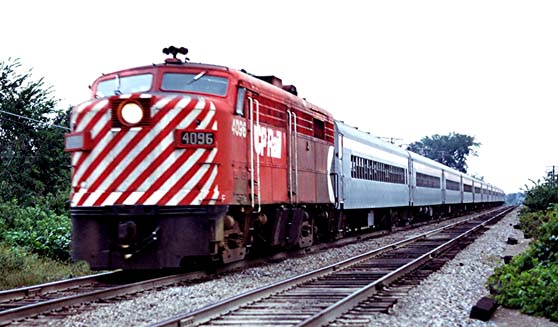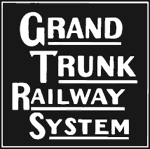
4 December 2010
The Golden Years of West Island Trains

|
Canadian Pacific commuter train - Date unknown Ron Visockis. |

Montreal Quebec - With all the talk, studies, and proposals for improved West Island
commuter-rail service, it is a good time to look at the history of Lakeshore commuter rail. It goes back farther than you might think.
The Montreal and Lachine Rail Road opened for business in 1847, running between Chaboillez Square in Montreal and the Lachine Wharf near today's 20th Ave. This
was the second railroad line in Canada (after the Champlain and St. Lawrence between La prairie and St. Jean) and it served as a way around the Lachine rapids.
By 1851 an intermediate station was built at Tanneries (renamed St. Henri in 1880). This was the infancy of rail transportation scheduled to accommodate daily
travellers to and from the city.
 In 1855, the Grand Trunk Railway linked Montreal to Brockville, Ont. After various mergers and lease agreements, the Montreal and Lachine was finally acquired
by the Grand Trunk in 1872. More stations were added, and by 1887 some 12 round trips were being operated weekdays over the line. In 1881, the Grand Trunk
extended the M&L westward (along Lachine's modern Victoria Ave.) to join its new Montreal-Toronto main line at Dorval.
In 1855, the Grand Trunk Railway linked Montreal to Brockville, Ont. After various mergers and lease agreements, the Montreal and Lachine was finally acquired
by the Grand Trunk in 1872. More stations were added, and by 1887 some 12 round trips were being operated weekdays over the line. In 1881, the Grand Trunk
extended the M&L westward (along Lachine's modern Victoria Ave.) to join its new Montreal-Toronto main line at Dorval.
It was an era of railroad competition. In 1887, Canadian Pacific opened a line from Place Viger Station in downtown Montreal to Smiths Falls, Ontario, running
parallel to the GTR line between Dorval and Vaudreuil. When Windsor Station opened in 1889, the circuitous route from Place Viger was eliminated and the CPR
was in a position to compete directly with the GTR for Lakeshore commuter business. Stops were established at Dorval, Bel Air (Pine Beach), Valois,
Beaconsfield, Ste. Anne, Vaudreuil, and by 1892 the CPR had extended service to Rigaud and Pointe Fortune.
The Grand Trunk, noting that Canadian Pacific was now engaged in a serious commuter-rail business, extended its own commuter service to Vaudreuil in 1896. In
1914, the Grand Trunk took delivery of six double-ended tank-type steam locomotives built specifically for the Lakeshore commuter service. The Grand Trunk was
acquired by the newly-formed Canadian National Railways in 1923. By that time Lakeshore trains were departing from Bonaventure Station. (They switched to
Central Station in 1948.)
In the early years of CP's Lakeshore service, long-distance trains were scheduled so that they could also carry commuters. In fact the nature of the traffic
was far different from today's. There were few daily travellers. In an era before highways and motor vehicles, the trains were used to bring milk and other
dairy products into the city, which is why the Guaranteed Milk Company, of which only the celebrated milk bottle water tank survives, was located close to
Windsor Station downtown.
The existence of competing train services, literally side by side, encouraged development, starting with summer cottages for the affluent. Initially families
spent their summers at the cottage, while the breadwinner came out each weekend. Vigorous promotional campaigns by the railways, the introduction of commuter
tickets, and an increased number of stations made year-round daily commuting easier. Increasingly, summer homes were winterized. The era of the year-round
commuter was born.
In 1953, the CPR ordered a fleet of 40 high-capacity, lightweight, commuter cars from Canadian Car and Foundry in Ville Saint Pierre. In 1957 the CPR
introduced self-propelled rail diesel cars on the Lakeshore service. And in 1970 the CPR purchased nine multi-level "gallery" cars from Canadian
Vickers Limited, the first "double deck" cars in Canada.
While Canadian National offered a substantial Lakeshore commuter service, it never matched that being offered by the CPR. For example, CN continued to use
wooden coaches right up until 1955, when the service was cut back to Dorval. And when heavyweight steel coaches were introduced, they were at first pulled by
the venerable 1914 tank engines. The CN Lakeshore commuter service was finally converted to diesel in late 1959, but discontinued on 30 Jun 1960.
On 1 Oct 1982 the Montreal Urban Community Transit Commission took over CPR's responsibility, and rolling stock, for the Lakeshore commuter service, the Agence
metropolitain de transport took over in 1995. Since that time, the AMT has been retiring outdated equipment, introducing new multi-level cars, and acquiring
new locomotives. It is continuing the essential service that began on the Montreal and Lachine Rail Road in 1847.
Peter Murphy - Vice-president Exporail.

|